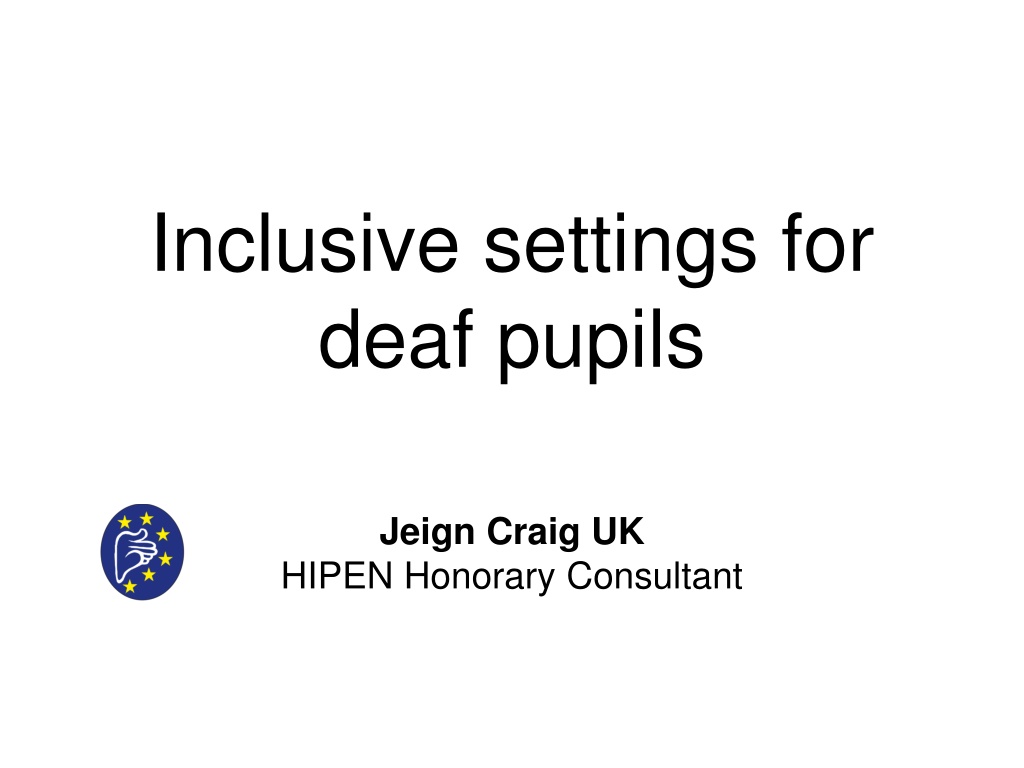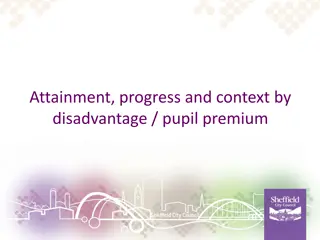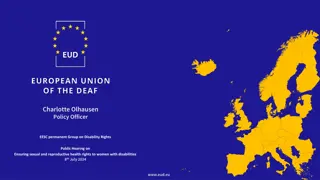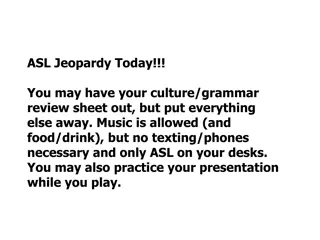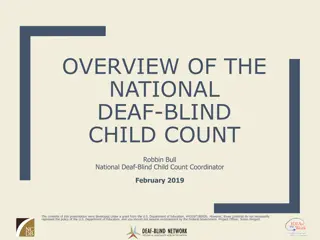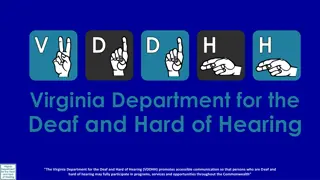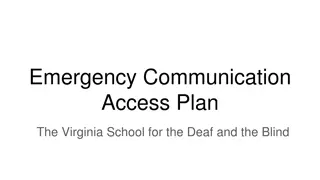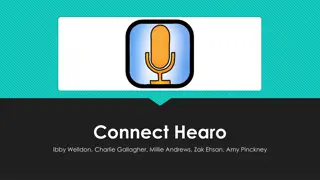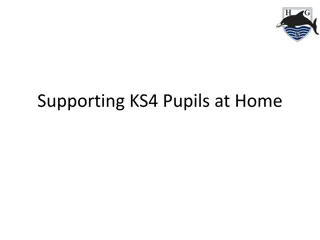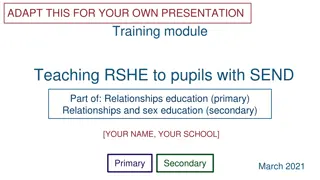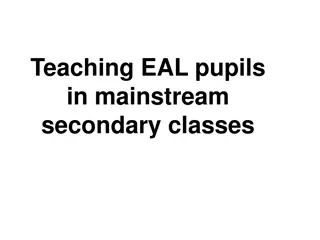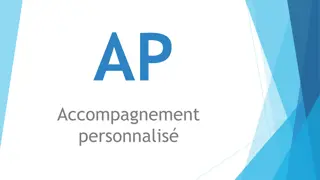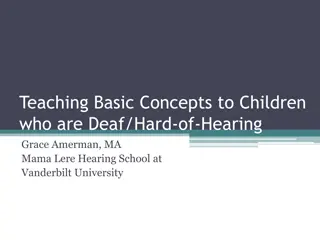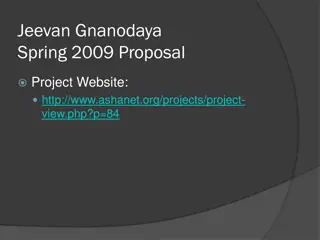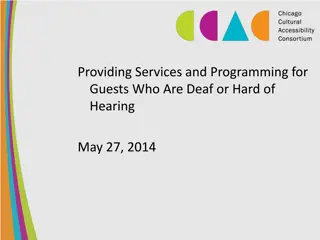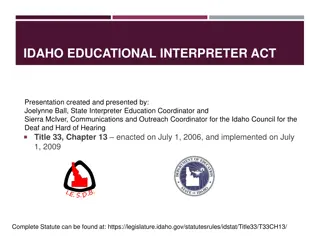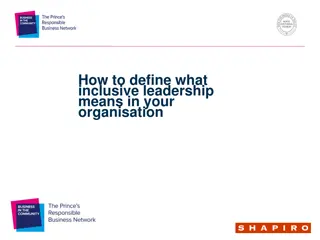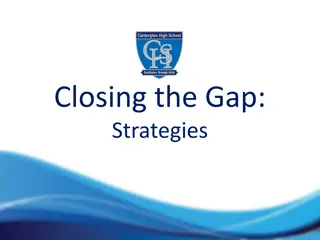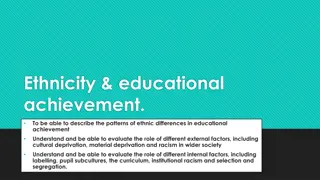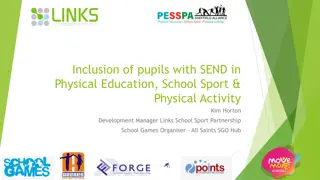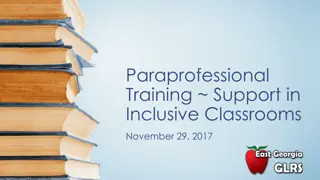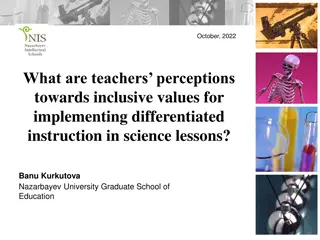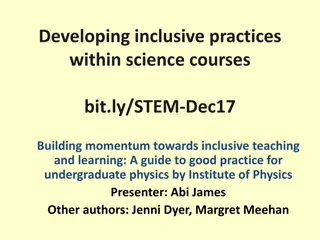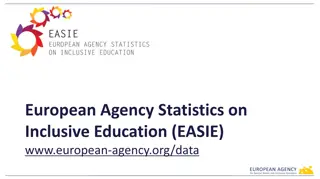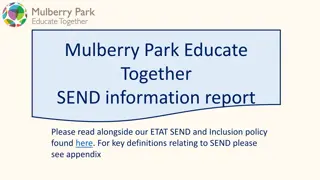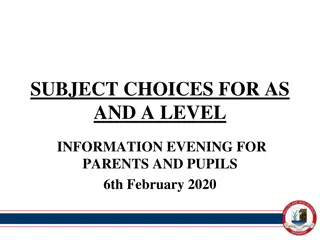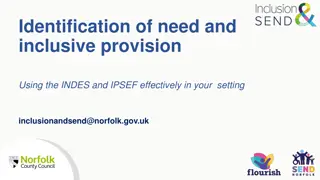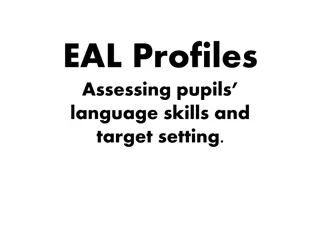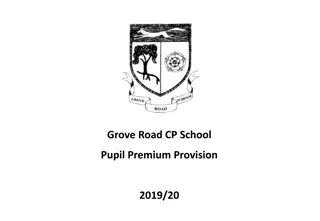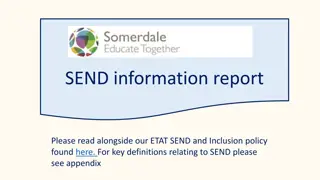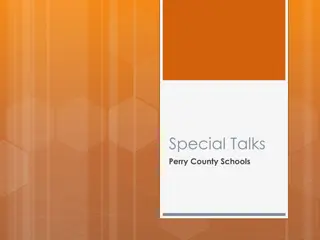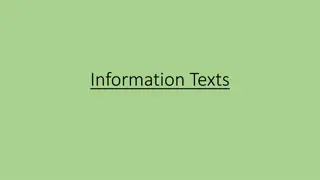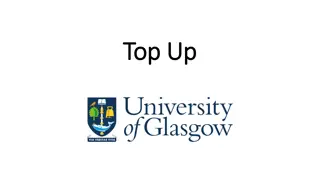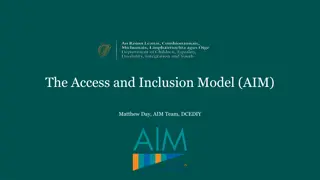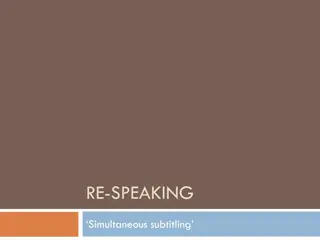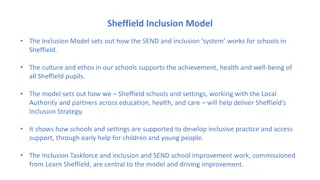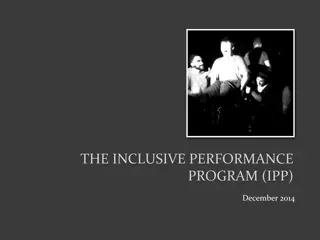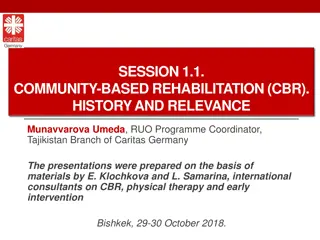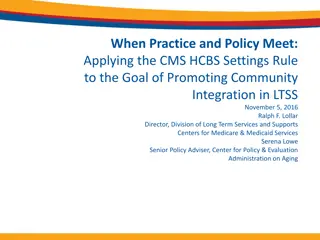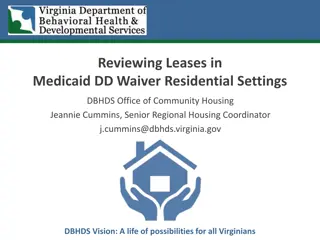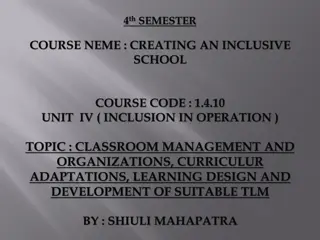Inclusive Settings for Deaf Pupils: UK Experience and Challenges
The UK has a history of deaf education dating back to 1825, with various models developed over the years for integrating deaf pupils into mainstream settings. However, challenges persist in providing specialized language and communication support for deaf children, impacting their learning and social well-being. The Education Acts of 1981 and 1983 marked significant legal milestones, but the journey towards true inclusion and support for deaf pupils continues.
Download Presentation

Please find below an Image/Link to download the presentation.
The content on the website is provided AS IS for your information and personal use only. It may not be sold, licensed, or shared on other websites without obtaining consent from the author. Download presentation by click this link. If you encounter any issues during the download, it is possible that the publisher has removed the file from their server.
E N D
Presentation Transcript
Inclusive settings for deaf pupils Jeign Craig UK HIPEN Honorary Consultant
UK experience 1980 - now Deaf schools established in UK from 1825 Opening of a few UNITS (attached to mainstream schools) from 1960s Different models developed - Class for deaf pupils in a mainstream school Partially Hearing Units (/Partially deaf units) Resource bases Resourced schools Mainstreaming Integration Inclusion
Integration - Inclusion of deaf pupils into mainstream Our experience in the UK has been the same as in many other countries, eg: France ,Germany, Norway, America, New Zealand, Australia Deaf mainstreaming - each development had good and bad factors - current provision is the result of more than 40 years of experience ! schools, followed by various types of
Remember the deaf child. Deafness means that a deaf child will not develop language without specialist intervention. Communication, speech, reading, writing, sign language - all have to be taught by specialist teachers. UK Education Acts (laws) 1981 and 1983 - In 1981 - the rights of all disabled people to be fully part of society - In 1983 - Children with learningdifficulties should be educated in ordinary schools (not only physical and mental disabilities but any leaning difficulty) - 1980s - we had Integration - these children had to fit into a mainstream school - 1990s - we had Inclusion - the school is responsible for making adjustments to provide appropriate provision
Remember the deaf child. The Education Acts did not provide for the best education for deaf children: Deaf Education was well established and Teachers of the Deaf had specialist qualifications. Teachers in mainstream had no understanding of teaching deaf pupils ( communication, language, speech, reading, writing, sign language). Local Authorities (Ministers of Education) wanted deaf children in mainstream - often because this saved money. Parents were happy because their children were seen as normal - but Deaf children failed because of their limited language acquisition, parents felt guilty and Deaf children had low self esteem. Many Deaf pupils had to be sent to the few remaining Schools for the Deaf where they arrived as failures from mainstream schools.
Remember the deaf child. Children need language to develop - to enable them to think, to communicate, to learn. Deaf pupils in mainstream became isolated: Most were unable to communicate with teachers or other children. Most had no peer group, they could not make any friends. Deaf pupils Social and Emotional well-being was affected. There were no r le models (successful older deaf students or deaf adults). Most deaf pupils were not included or integrated - they were isolated. [Research: Social & Emotional Well-being, Watsons and Parsons 1991]
Remember the deaf child. Deafness means that a deaf child will not develop language without specialist teaching. It was found that Deaf pupils who did use spoken language, that no matter how good the support they had, some pupils find that understanding the spoken language of the classroom is very limited and they are not able to participate . [Research: Language Interactions - Gregory and Bishop 1987; Hopwood 2003]
Problems in mainstream schools for deaf children: Environment - Class size - too big. Noise level - too high (children s chatter, furniture scraping). Acoustic treatment - too limited. The deaf pupil unable to see the teacher all the time. Teacher Deaf pupils need to see the teacher s face to lipread. The teacher must stand still, not cover mouth, not move head, repeating what other children say/ their answers. The teacher must not talk and point (picture/map/diagram etc) at the same time. All of which a Teacher of the Deaf is trained to do; but this slows down lessons for normal hearing pupils. Technology - hearing aids / FM microphone etc Amplification (hearing aids etc) - amplify ALL sound not just speech, so deaf pupils receive distorted signals Cannot be used in swimming / sports classes Deaf pupils need to be close to the teacher. Distance from teacher - large groups, outside - study, trips. All of which a Teacher of the Deaf is trained in doing.
Problems for Deaf pupils in mainstream school Language and Communication Remember -Deafness means that a deaf child will not develop language (communication, speech, reading, writing, sign language) without specialist teaching. Communication How does the deaf pupil communicate ? speech or sign language? Can others understand the deaf pupils speech? What can the deaf pupil hear, with technology ? Hearing aids amplify ALL SOUND not just speech ! There will be classroom noise, traffic, aeroplanes, roadworks, grass cutting, building works - all will interfere with what the deaf child hears, affecting concentration and understanding speech. Is the room acoustically treated? Is the light good? Are they sitting close to the teacher? All necessary for Deaf pupils to begin learning. Language A deaf pupil may be 11 years old with a language level of a 5 year old - which class do they go to? (Physically & socially 11 years old but not linguistically). This is the problem for inclusion. A deaf pupil will have a lower reading level than the class. They cannot read the written texts in the lessons. Teachers of the Deaf are trained to modify language and not the content. Deaf pupils will have a different language level to the other pupils. They cannot work with others, understand lessons or make friends.
Inclusion for deaf pupils who sign Inclusion for deaf pupils who use Sign Language should be with other signing deaf children. They cannot be included in school if they cannot easily communicate or follow the communication of other pupils This is supported by UNESCO Statement 1994 Owing to the particular communication needs of deaf (and deaf/blind) persons, their education may be more suitably provided in special schools or special units in mainstream schools. Many deaf pupils who sign are now educated in mainstream school - how are their needs being met?
To educate each child to his/her full potential Don t waste skills Experienced, knowledgeable Teachers of the Deaf should be teaching deaf pupils. Mainstream teachers do not have the skills to teach deaf pupils. Is it cost effective? Teachers of the Deaf travelling between mainstream schools. Their r le has changed - now there is less face to face teaching to give support and advice to mainstream teachers. [Mainstream teachers do not have the knowledge or expertise to teach Deaf pupils, and they may be coping with children having other disabilities.] Is it cost effective? To equip all schools with acoustic and environmental aids in case they may have a deaf pupil. Do all deaf pupils have the support they need so they can learn? Deaf children only learn with specialist teaching. CONCULSION (from experience): Yes, develop mainstreaming provision with specialist support AND keep open Schools for the Deaf, Units /Resource Centres- so every deaf child can be successfully educated.
What have we learned? 1960s the majority of deaf pupils were educated in special schools for the deaf. 2010 onwards the majority of deaf pupils are being educated in mainstream. This has not been simple or easy. Each development has merit but always with problems to be solved. Our Conclusion - there is no one approach that is best for all, so: - develop mainstream with specialist support, - keep Deaf Schools open, - and continue training for Teachers of the Deaf
Current model of education (UK +) - keep all provision - Always consider language and communication Deaf pupils in mainstream schools with specialist support Units attached to mainstream schools (pupils and professionals less isolated) Deaf schools for day and residential pupils choices Pupils can move, depending on success (not failure), Skills and availability of professionals: Teachers of the Deaf, in-class Support staff (CSWs)
Communication Support Workers (CSWs) A new profession evolved as a result of Inclusion of deaf pupils in mainstream. There is a training course with qualifications. A Communication Support Worker (CSW) within ALL educational settings: enables access to communication. uses support strategies and communication modes to match each pupil s needs. Liaises with other professionals: Teachers of the Deaf, audiologists, teachers, lecturers, other CSWs and team leaders Follows a professional Code of Practice The CSW Qualification includes - Knowledge of Deafness,Language development, Deaf Culture, Hearing aids - Audiology, Classroom management, Deaf Awareness for teachers, other staff and hearing pupils. CSWs have additional qualifications: Sign language, Lip- speaking (clear speech), Note- taking, Cued Speech.
Accesses all communication: -teacher to deaf pupil -deaf pupil to teacher -deaf pupil to other children -other children to deaf pupil -other staff to deaf pupil -deaf pupil to everybody -film/ recordings etc to deaf pupil -written texts to deaf pupil Follows a professional Code of Practice Ability to use all communication modes Communica tion Support Workers CSW Qualification includes: - Knowledge of deafness - Language development - Deaf Culture - Hearing aids, Audiology - Classroom management - Delivering Deaf Awareness to teachers, other staff and hearing pupils. Able to match support to each pupils needs Liaises with other professionals: - Teachers of the Deaf - Audiologists - teachers /lecturers - other CSWs - Team Leaders Additional Qualifications: - Sign language - Lip- speaking (clear speech) - Note-taking - Cued Speech
European experiences Examples: Norway ( resource centres across the country) Finland (closing of Deaf Schools after Cochlear Implants, now re-opening centres) France (recognition of early years language development before mainstreaming) Professional Associations: Isolation of Teachers of the Deaf from their colleagues with experience of Deaf pupils has lead to development of professional associations in for example, UK, Germany British Association of Teachers of the Deaf - this is active throughout the year with : - Research into Deaf Education - Training Courses - Conferences - Bi-monthly Magazines for reviews in audiology, language, communication and speech teaching , syndromes, technology, books, teaching materials, parent interaction, Assessments, Professional development etc European Networks HIPEN Hearing Impaired Professionals European Network - 17 organisations across Europe, meetings, European Project FEAPDA The European Federation of Associations of Teachers of the Deaf - bi-yearly conferences
